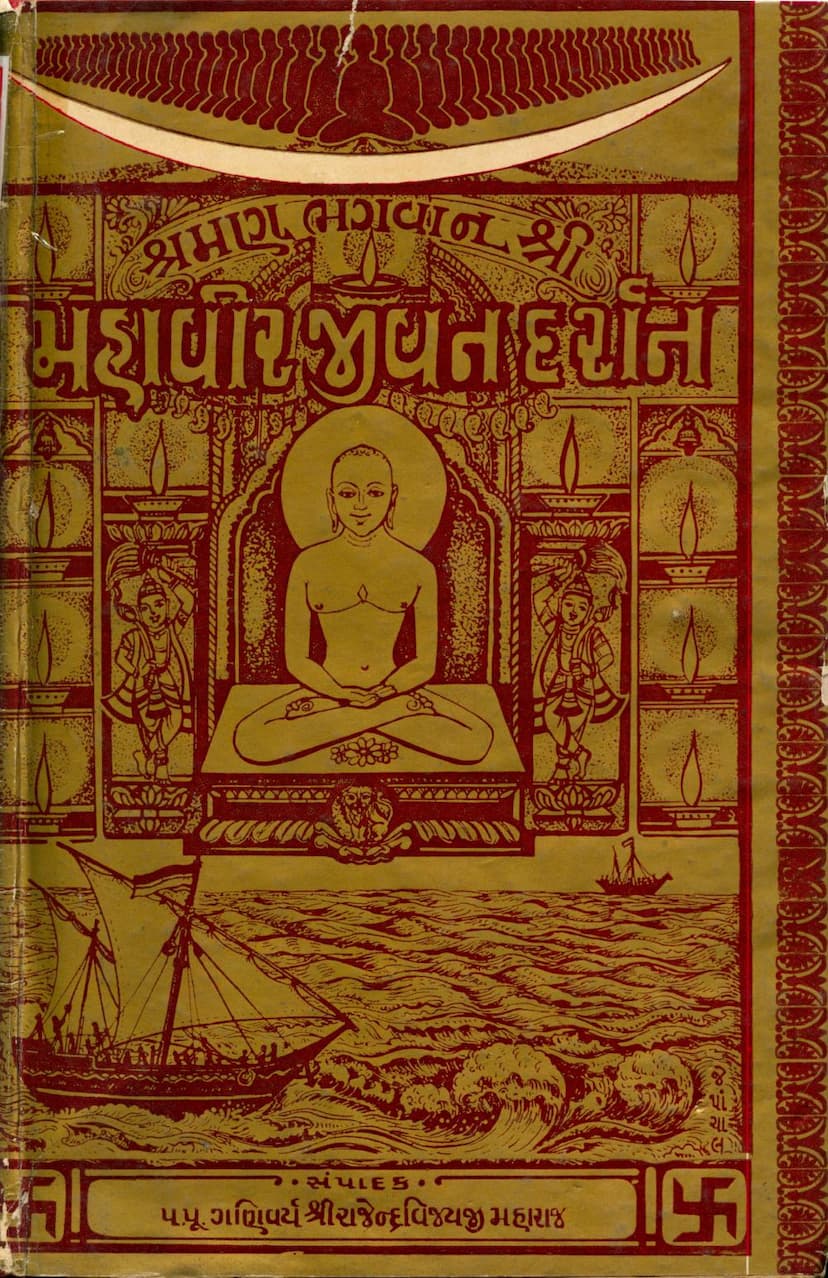Mahavir Jivan Darshan Sachitra
Added to library: September 2, 2025

Summary
Here is a comprehensive summary in English of the Jain text "Mahavir Jivan Darshan Sachitra":
Mahavir Jivan Darshan Sachitra: A Visual Journey Through the Life and Teachings of Lord Mahavir
This book, published by Shri Mahavir Tattvagyan Pracharak Mandal (Anjar-Kutch), is a meticulously compiled and illustrated guide to the life, teachings, and spiritual journey of Lord Mahavir, the 24th Tirthankar of Jainism. Edited by Ganivarya Shri Rajendravijayji Maharaj, the work aims to provide readers with a deep and accessible understanding of the spiritual principles and historical context of Jainism.
Key Themes and Content:
The book embarks on a detailed narrative of Lord Mahavir's life, tracing his spiritual evolution across 27 lifetimes, culminating in his attainment of omniscience and liberation. The core themes explored include:
-
The 27 Lifetimes of Lord Mahavir: The book meticulously details the significant events and experiences from each of Mahavir's past lives that contributed to his spiritual development. It highlights key figures and episodes, such as:
- Naysar: His first human birth after attaining right faith (Samyakdarshan), where he performed the act of feeding monks, laying the foundation for his Tirthankar name.
- Marichi: His birth as the grandson of Rishabhdev, where initial adherence to monastic discipline later deviated into heterodox practices.
- Triprishtha Vasudev: A life marked by great strength and power, but also involving experiences in hellish realms due to previous actions.
- Nandan Rajarshi: A life of intense penance and devotion, culminating in the attainment of the Tirthankar name karma through the rigorous "Vishisthanak Tap."
- Vimal Kumar and Priyamitra Chakravarti: Lives characterized by virtuous conduct, administrative skills, and the eventual renunciation of worldly pleasures for spiritual pursuit.
- Triprishtha Vasudev and Vishwabhuti Kumar: These lifetimes exemplify the cyclical nature of karma, illustrating both downfall due to anger and delusion, and eventual rise through wisdom and renunciation.
- The "Sargam Upasarg" episodes: The book details the numerous challenges and torments Mahavir faced from the demon Sangam Dev and others, showcasing his unwavering equanimity, strength, and commitment to his vows. These stories serve as powerful examples of overcoming adversity through spiritual discipline.
- Chandkaushik the Serpent: A significant episode illustrating Mahavir's compassion and his ability to bring about transformation even in the most formidable and wrathful beings through his divine presence and teachings.
- The "Kambal-Shambal" episode: This narrative highlights the profound influence of virtuous association and the impact of following righteous paths, even for animals.
- The "Ardhvastra Daan" (Half-Robe Donation): This episode emphasizes Mahavir's boundless compassion and generosity, even when facing personal hardship.
- The "Pāranā" (Breaking of Fast) by Chandanbala: This crucial event marks the breaking of Mahavir's severe penance and signifies the establishment of the Jain Sangha.
- The Life of Vardhaman Kumar: The book covers his princely life, marriage to Yashoda, his family, and the eventual path to renunciation.
- The Kevalgyan and Nirvana: The culmination of his spiritual journey, the attainment of omniscience, the establishment of the four-fold Jain community (monks, nuns, male and female lay followers), and his ultimate liberation (Nirvana) are vividly described.
-
Illustrations: The book is richly illustrated with paintings and artwork depicting key moments from Mahavir's lives. These visuals are integral to the narrative, making the spiritual and historical accounts more engaging and comprehensible for the reader.
-
Philosophical and Ethical Teachings: Beyond the biographical narrative, the book implicitly and explicitly conveys core Jain philosophical concepts:
- Karma: The pervasive influence of karma in shaping one's destiny across multiple lifetimes is a central theme. The stories illustrate how past actions lead to present consequences, both positive and negative.
- Ahimsa (Non-violence): The paramount importance of non-violence is evident in Mahavir's interactions and his teachings.
- Renunciation and Detachment: The book repeatedly showcases the virtue of renouncing worldly pleasures and attachments in the pursuit of spiritual liberation.
- Equanimity (Samata): Mahavir's ability to remain calm and composed in the face of extreme hardship and suffering is a recurring message.
- Compassion (Karuna): His acts of compassion towards all beings, including animals and those who caused him harm, are highlighted.
- Right Faith, Right Knowledge, Right Conduct (Samyakdarshan, Samyakgnan, Samyakcharitra): These form the foundation of the path to liberation, and Mahavir's lives are presented as the embodiment of these principles.
-
Historical and Geographical Context: The narrative provides geographical references to places significant in Jain history, such as Pavapuri, Bhadreshwar (Vasai), and various cities in ancient India.
-
The Graph of Spiritual Evolution: A significant visual element is the graph at the end of the book, which chronologically maps Mahavir's soul's journey across his 27 lifetimes, indicating the ups and downs, the gains and losses, and the progressive purification of his soul towards the ultimate goal of omniscience and liberation.
Overall Purpose:
"Mahavir Jivan Darshan Sachitra" serves as an educational and devotional resource. It aims to:
- Inspire Faith and Devotion: By presenting Mahavir's life in such a comprehensive and visually rich manner, the book seeks to deepen the reader's faith and devotion towards him.
- Educate about Jain Principles: It offers a detailed yet accessible explanation of Jain philosophy, ethics, and history.
- Provide a Guiding Light: The life of Mahavir is presented as a beacon of spiritual aspiration, guiding individuals towards self-improvement and the ultimate goal of liberation.
- Preserve and Propagate Jain Heritage: Through its detailed accounts and illustrations, the book contributes to the preservation and dissemination of Jain heritage for future generations.
The book is a valuable addition to Jain literature, making the profound spiritual journey of Lord Mahavir relatable and inspiring through its engaging narrative and captivating imagery.